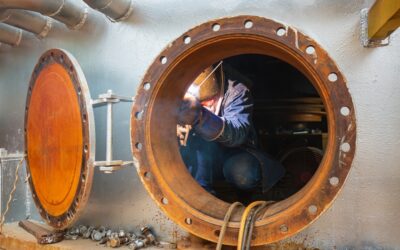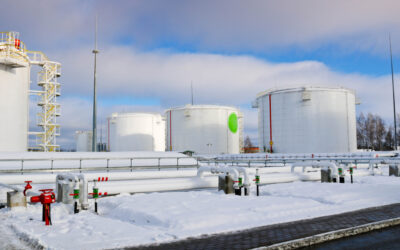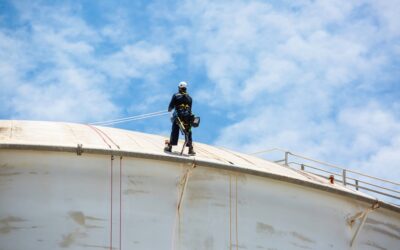When your equipment is exposed to harsh chemicals day in and day out, selecting the right rubber lining material is vital. The wrong choice can lead to premature failure, unplanned downtime, and costly repairs. The right material, on the other hand, can provide long-lasting protection, reduce maintenance needs, and help your operation run smoothly for years to come.
But with so many chemical environments and rubber formulations available, how do you know which rubber lining material is best?
Let’s walk through six key factors to consider when selecting a rubber lining for chemical resistance. We’ll provide a quick breakdown of common rubber materials and their compatibility with different chemicals, temperatures, and mechanical demands. And when it’s time to put that lining into service, you’ll see why working with a trusted partner like US Rubber ensures both the right material and a reliable installation.
6 Things to Consider When Choosing a Rubber Lining for Chemical Resistance
The right rubber lining material protects your equipment, extends service life, and reduces costly maintenance—but only if it’s chosen with your specific chemical environment and operating conditions in mind. Below are six key factors to help guide your selection.
1. Understand Your Chemical Environment
Before you choose a rubber lining material, you need to know exactly what it’s up against. Start by identifying all the chemicals your equipment will come into contact with (Ex. acids, alkalis, solvents, oxidizers, a mix of several, etc.)
It’s also important to assess:
- Concentration levels: A low concentration of an acid might be fine for some materials, but higher levels could cause degradation.
- Exposure duration: Is the chemical contact constant, intermittent, or just occasional?
- Combination effects: Even if individual chemicals are compatible, mixtures can create unexpected reactions that affect performance.
Pro tip: Remember trace chemicals or cleaning agents—if they’re not considered in the selection process, they can slowly degrade the lining over time.
2. Consider Operating Conditions
Chemical exposure is only part of the equation. Your rubber lining also needs to perform under the physical demands of your system. Be sure to factor in:
- Temperature: High heat can accelerate chemical reactions and degrade some rubber materials, while extreme cold may cause brittleness or cracking. Choose a lining rated for your maximum operating temperature.
- Pressure and mechanical stress: Equipment that experiences internal pressure, movement, or flexing requires a rubber lining that offers both elasticity and durability to prevent cracking or delamination.
- Abrasive media: If your chemicals are part of a slurry or contain suspended solids, you’ll need a material that offers abrasion resistance in addition to chemical protection.
Remember: Even a rubber that performs well chemically might still fail prematurely if it cannot handle the system’s mechanical or thermal loads.
3. Cured vs. Uncured Rubber Linings
Another critical consideration is whether to use cured or uncured rubber lining. Each has advantages, and the right choice depends on your application and installation environment.
- Cured Rubber Linings:
- Pre-vulcanized before application
- Offer consistent properties and quick installation
Easier to inspect for uniformity and defects - Ideal for simpler surfaces and controlled shop conditions
- Uncured Rubber Linings:
- Applied in an uncured state and vulcanized after installation
- Allow for better conformity to complex or irregular surfaces
- Require skilled technicians and careful process control to ensure a complete cure
- Often used in the field or for large, custom installations
In general: Cured linings are great when time and predictability matter, while uncured linings offer flexibility for more challenging or custom applications.
4. Compare Rubber Lining Material Options
Not all rubber is created equal, especially when it comes to chemical resistance. Each compound has its own strengths and weaknesses, depending on the chemicals, temperatures, and conditions involved.
Below is a quick comparison of common rubber lining materials and their chemical resistance properties:
Natural Rubber (NR)
Best for: Mild acids, alkalis, and abrasion
Avoid with: Oils, solvents, and oxidizers
Neoprene (CR)
Best for: Moderate acids and alkalis, ozone, and weathering
Avoid with: Strong oxidizers, aromatic solvents
EPDM
Best for: Hot water, steam, acids, and alkalis
Avoid with: Oils, hydrocarbons
Chlorobutyl (CIIR)
Best for: Oxidizing chemicals, steam, and permeation resistance
Avoid with: Strong solvents
Hypalon (CSM)
Best for: UV exposure, weathering, and mixed chemical environments
Avoid with: Ketones, esters
Nitrile (NBR)
Best for: Oils, fuels, greases
Avoid with: Strong acids and oxidizers
Viton® (FKM)
Best for: Aggressive solvents, high temperatures, concentrated acids
Avoid with: Some low-temperature environments
5. Don’t Overlook Compatibility and Longevity
Even if a rubber material is technically rated for your chemicals, that doesn’t guarantee long-term performance. Real-world conditions often introduce variables that accelerate wear or reduce effectiveness. To make sure your lining lasts:
- Validate with real-world experience: Chemical resistance charts are helpful, but field performance and case studies give a more complete picture.
- Consider permeability and diffusion: Some chemicals may slowly penetrate the lining over time, especially at higher temperatures.
- Account for thermal expansion and contraction: Repeated heating and cooling can stress the bond between the lining and substrate.
- Watch out for chemical combinations: Certain mixtures may create new byproducts or reactions that weren’t considered during initial material selection.
Keep in mind: A lining that works well on paper may not be the most economical or durable choice in practice. Longevity matters just as much as initial compatibility.
6. Work with a Certified Rubber Lining Partner
Selecting the right rubber lining material is only half the equation. Even the most chemically resistant rubber won’t perform as expected if it’s installed improperly.
That’s why working with a certified partner who understands both material science and installation best practices is critical.
When you work with US Rubber, you get:
- Expert guidance on material selection based on your specific chemical environment and mechanical needs
- Certified field and shop crews equipped to handle everything from tank linings to complex vessels
- 24/7 installation and repair services to minimize downtime
Full documentation and inspection reports to support traceability, compliance, and long-term maintenance planning
In short: An ideal rubbing lining partner will help you choose the right material and install it the right way, so you can protect your equipment and keep operations running smoothly.
Get Chemical Resistance You Can Count On
Rubber lining is one of the most effective ways to protect your equipment from chemical attack—but only if you choose the right material and install it properly.
Need help determining the best rubber lining material for your application?
US Rubber is here to help. Our experienced team can recommend the proper lining based on your exact requirements—and back it up with expert installation and support.
Contact us today to speak with a specialist or request a quote.







